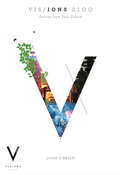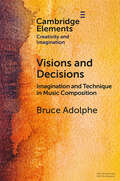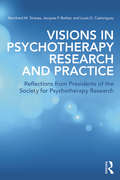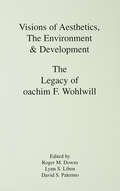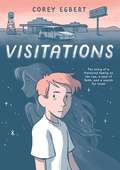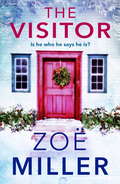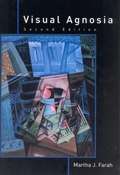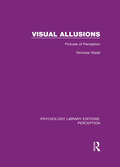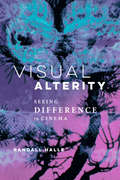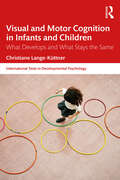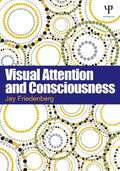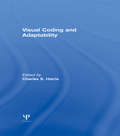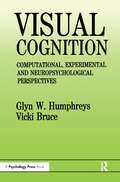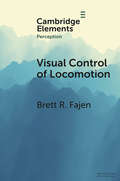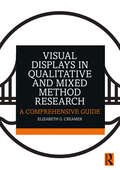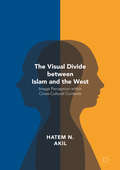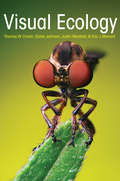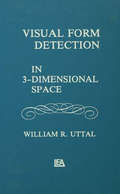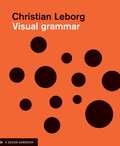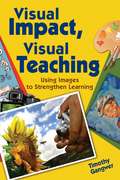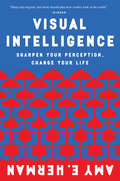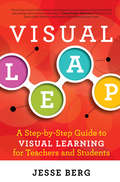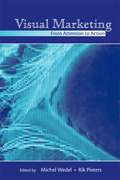- Table View
- List View
VISIONS 2100: Stories from Your Future
by John K. O'BrienStories from Your Future The complex issue of climate change is one that our race is struggling to address. The solutions are not beyond us in any way. Technological solutions exist, scientific knowledge is plentiful, the world can afford the transition but still significant action eludes us. Rational arguments for rapid action abound. We do not need any more of those. What is needed is a different way of communicating that inspires and attracts the widest possible group of humans towards wanting to travel on this same journey. As part of the VISIONS 2100 Project, this book tells of the power of Visions and invites the reader to create and share their own vision of a better world. Only by starting conversations of the future will we manage to build the world that we really want. The book balances worries about catastrophe with social and environmental improvements by referencing psychology, management thought, case studies and personal anecdotes. In also references the parallels between the world's journey and coping with the chronic illness of the author's wife. The book is framed around eighty short visions by some of the world's leading environmental thinkers including Mary Robinson, Christiana Figueres, Bill McKibben, Connie Hedegaard, Yvo de Boer and many others. Having a vision of a better world is likely to result in the world being better. 'Poverty is eradicated. Every child goes to school regardless of sex, race, religion or place of birth. Every woman enjoys equality with every man. Every household has access to energy. In 2100, the world is just.' Mary Robinson, Special Envoy on Climate Change, United Nations'Opportunity from 2100 forward is unimaginably vast and incredibly varied.' Christiana Figueres, Executive Secretary, UNFCCC 'Timing is everything, and it hurts to think we blew it.' Bill McKibben, 350.orgThe future is a beautiful, if challenging, partner. Your choice is whether you take the risk in having a first date or whether you are happy to accept a life of regret.www.visions2100.com
Visions and Decisions: Imagination and Technique in Music Composition (Elements in Creativity and Imagination)
by Bruce AdolpheThis Element investigates the balance and interaction of imagination (visions) and technique (decisions) in the composition of music and includes current scientific research on dreams, the hypnagogic state, emotions, and feelings. It also includes thoughts of composers past and present, and examines how works start from visions in a range of music, comparing musical ideas and techniques to models in other creative disciplines. The Element elucidates aspects of musical discourse by imagining how Haydn, Mozart, and other composers would order falafel for takeout. This unorthodox approach emphasizes parallels between music and theater that are central to this Element.
Visions in Psychotherapy Research and Practice: Reflections from the Presidents of the Society for Psychotherapy Research
by Bernhard Strauss Jacques P. Barber Louis CastonguayThe Society for Psychotherapy Research (SPR) is devoted to the development and dissemination of research, as well as the integration of empirical, theoretical, and clinical knowledge in psychotherapy. A highlight of the SPR annual meeting is the presidential address, wherein the president delivers what many view as the most important presentation of their career. In Visions of Psychotherapy, Bernhard Strauss, Jacques Barber, and Louis Castonguay, three recent past presidents, compile the preceding 20 presidential addresses from SPR into a single volume. Then, the living presidents (19 of the 20) comment on how the visions they described in their addresses have developed over time.
Visions of Aesthetics, the Environment & Development: the Legacy of Joachim F. Wohlwill (Penn State Series on Child and Adolescent Development)
by Roger M. Downs Lynn S. Liben David S. PalermoDerived from a conference honoring the legacy of Joachim Wohlwill, this volume is designed to reflect as many facets of the late scholar's wide-ranging work as possible. As its title indicates, the book identifies three broad areas in which Wohlwill made significant contributions: art and aesthetics, human-environment interaction, and concepts of development. In each of these areas Wohlwill made seminal contributions, helping to shape, maintain, and even change the direction of research and thought. Specific topics addressed here by his colleagues, students, and contemporaries include: the shape of development, the intermingling of perception and cognition, the balance between innate and acquired processes, the relation between environmental and ecological psychology, the development of the ability to use external representations of the physical environment, and the way world views underpin beliefs about the nature of development.
Visions of the Crow (Dreams #1)
by Wanda John-Kehewin&“Your ancestors have called us to help you.&”&“I think y'all have the wrong number.&” Damon Quinn just wants to get through his senior year unscathed. His mom struggles with alcohol and is barely coping with the day-to-day. Marcus and his cronies at school are forever causing Damon trouble. The new girl, Journey, won't mind her own business. To make matters worse, now a mysterious crow is following him everywhere. After he is seized by a waking dream in the middle of a busy street, Damon is forced to confront his mom with some hard questions: Why haven't I met my dad? Where did we come from? Who am I? Damon must look within himself, mend the bond with his mother, and rely on new friends to find the answers he so desperately needs. Travelling through time and space, Damon will have to go back before he can move forward.
Visions of the Crow (Dreams #1)
by Wanda John-Kehewin&“Your ancestors have called us to help you.&”&“I think y'all have the wrong number.&” Damon Quinn just wants to get through his senior year unscathed. His mom struggles with alcohol and is barely coping with the day-to-day. Marcus and his cronies at school are forever causing Damon trouble. The new girl, Journey, won't mind her own business. To make matters worse, now a mysterious crow is following him everywhere. After he is seized by a waking dream in the middle of a busy street, Damon is forced to confront his mom with some hard questions: Why haven't I met my dad? Where did we come from? Who am I? Damon must look within himself, mend the bond with his mother, and rely on new friends to find the answers he so desperately needs. Travelling through time and space, Damon will have to go back before he can move forward.
Visitations
by Corey EgbertInspired by true events, this haunting yet hopeful young adult graphic novel weaves together family dynamics, mental illness, and religion—perfect for fans of Hey, Kiddo.Corey’s mom has always made him feel safe. Especially after his parents’ divorce, and the dreaded visitations with his dad begin. But as Corey grows older, he can’t ignore his mother’s increasingly wild accusations. Her insistence that God has appointed Corey as his sister’s protector. Her declaration that Corey’s father is the devil.Soon, she whisks Corey and his sister away from their home and into the boiling Nevada desert. There, they struggle to survive with little food and the police on the trail. Meanwhile, under the night sky, Corey is visited by a flickering ghost, a girl who urges him to fight for a different world—one outside of his mother’s spoon-fed tales, one Corey must find before it’s too late.Drawing inspiration from his own upbringing in the Mormon church, Corey Egbert welcomes readers on an emotionally stirring, nuanced journey into the liminal spaces between imagination and memory, faith and truth.
The Visitor: Is he who he says he is?
by Zoe MillerIs he who he says he is?Izzie Mallon is looking forward to celebrating Christmas on a relaxing yoga retreat. At least, that is what she's telling her mother and colleagues. In reality, she will be shutting herself away from the festive season, and the snowstorm that has brought the city to a standstill, in her apartment on Henrietta Square -- the beautiful home she shared with her beloved husband Sam until his tragic death a few months ago -- with only her grief for company.Then, there's a knock at the door -- a stranger, stranded by the bad weather.He tells Izzie that he's Eli Sanders, her husband's long-time friend. Izzie has never met him in person, but feels she owes it to Sam to welcome Eli into her home. Even though her instincts say that she should do otherwise...As Izzie tries to reminisce with Eli about her husband, cracks in his story begin to show. But will she be able to see clearly through her grief before it's too late?
Visual Agnosia (Second Edition)
by Martha J. FarahThe second edition of the classic book on visualagnosia, updated to include disorders of semantic knowledge andtopographic recognition, and integrating perspectives from functional neuroimaging throughout.
Visual Allusions: Pictures of Perception (Psychology Library Editions: Perception #32)
by Nicholas WadeIn this book a leading researcher and artist explores how we see pictures and how they can communicate messages to us, both directly and indirectly by making allusions to objects in space or to stored images in our minds. Originally published in 1990, Dr Wade provides fascinating examples of pictures that communicate hidden messages, either by implying something else, or by a shape or portrait which is carried covertly within another design. He analyses image processing stages in vision, demonstrating that the various stages may be related to styles in representational art. He shows how the way we have been taught to look at and recognise objects, affects the way we see them. The book lavishly illustrates with original examples of visual allusions and includes detailed practical advice on how photographers and designers can create them. Essential reading for photographers, designers, artists, people in film and television, and anyone involved in visual science , visual communication and advertising.
Visual Alterity: Seeing Difference in Cinema
by Randall HalleReconsidering the dynamics of perception Using cinema to explore the visual aspects of alterity, Randall Halle analyzes how we become cognizant of each other and how we perceive and judge another person in a visual field. Halle draws on insights from philosophy and recent developments in cognitive and neuroscience to argue that there is no pure "natural" sight. We always see in a particular way, from a particular vantage point, and through a specific apparatus, and Halle shows how human beings have used cinema to experiment with the apparatus of seeing for over a century. Visual alterity goes beyond seeing difference to being conscious of how one sees difference. Investigating the process allows us to move from mere perception to apperception, or conscious perception. Innovative and insightful, Visual Alterity merges film theory with philosophy and cutting-edge science to propose new ways of perceiving and knowing.
Visual and Motor Cognition in Infants and Children: What Develops and What Stays the Same (International Texts in Developmental Psychology)
by Christiane Lange-KüttnerThis insightful book offers an authoritative yet accessible introduction to the development of visual abilities and motor skills in infants and children. Based on theory and cutting-edge up-to-date research about the development of non-verbal intelligence, it provides readers with essential knowledge about the foundations of typical and atypical development.Split into two parts, the book begins by describing the development of components of non-verbal intelligence in typical development. Several studies are presented that document the importance of a transition from an object-place to objects-region encoding for proper spatial categorisation. In the second part, the book discusses which of the visual, spatial, motor, imagery, categorisation, memory and planning processes may be affected in children with attention deficit hyperactivity disorder (ADHD), autistic spectrum disorder (ASD) and developmental coordination disorder (DCD). Lange-Küttner introduces a Spatial Model that integrates object salience, speed and abstraction of spatial patterns of locations, re-occurring at different ages. She also develops a Spatial Freedom Theory that argues that spatial containment, constraints and exploration belong together.The book encourages and stimulates new research ideas by discussing the most important research results to date and identifying new research questions. This text will be of interest to students and instructors as well as researchers in the fields of developmental, clinical, educational and cognitive psychology as well as neuroscience and physical education.
Visual Attention and Consciousness
by Jay FriedenbergConsciousness is perhaps one of the greatest mysteries in the universe. This ambitious book begins with a philosophical approach to consciousness, examining some key questions such as what is meant by the term "conscious," and how this applies to vision. The book then explores major visual phenomena related to attention and conscious experience—including filling-in processes, aftereffects, multi-stability, forms of divided attention, models of visual attention, priming effects, types of attentional blindness and various visual disorders. For each phenomenon, the biological and cognitive level research is reviewed. Themes touched upon throughout are the relation between consciousness and attention, automatic vs. willful processes, singularity vs. multiplicity, and looking without seeing. The book concludes with an evolutionary approach, describing possible functions that visual consciousness may serve and how those may affect the way we see. The systematic review of key topics and the multitude of perspectives make this book an ideal primary or ancillary text for graduate courses in perception, vision, consciousness, or philosophy of mind.
Visual Coding and Adaptability
by Charles S. HarrisFirst published in 1980. This book is the first integrated presentation of two of the most active areas in present-day visual research. Its inspiration and nucleus were provided by two Optical Society of America symposia, one on the coding of spatial information in the visual system and the other on adaptability of the visual system. Although the two topics might seem, at first sight, only distantly related, they are actually extensively intertwined in contemporary research. Some investigators focus on mechanisms of visual analysis but rely on experimental modification of perception to reveal the nature of the coding; others focus on perceptual modification but look at analytic elements for indications about what it is that gets modified. Likewise, most of the chapters in this book combine, in varying proportions, both themes. Adult human perception is the primary concern, but illuminating data from animal, infant, and neurophysiological studies are also discussed.
Visual Cognition: Computational, Experimental and Neuropsychological Perspectives
by Glyn W. Humphreys Vicki BruceVision allows us to do many things. It enables us to perceive a world composed of meaningful objects and events. It enables us to track those events as they take place in front of our eyes. It enables us to read. It provides accurate spatial information for actions such as reaching for or avoiding objects. It provides colour and texture that can help us to separate objects from their background, and so forth. This book is concerned with understanding the processes that allow us to carry out these various visually driven behaviours. In the past ten years our understanding of visual processing has undergone a rapid change, primarily fostered by the convergence of computational, experimental and neuropsychological work on the topic. Visual Cognition provides the first major attempt to cover all aspects of this work within a single text. It provides a summary of research on visual information processing, relevant to advanced undergraduates, postgraduates and research workers. It covers: seeing static forms, object recognition, dynamic vision (motion perception and visual masking), visual attention, visual memory, visual aspects of reading. For each topic, the relevant computational, experimental and neuropsychological work is integrated to provide a broader coverage than that of other texts.
Visual Control of Locomotion (Elements in Perception)
by Brett R. FajenThis Element examines visual perception in the context of activities that involve moving about in complex, dynamic environments. A central theme is that the ability of humans and other animals to perceive their surroundings based on vision is profoundly shaped by the need to adaptively regulate locomotion to variations in the environment. As such, important new insights into what and how we perceive can be gleaned by investigating the connection between vision and the control of locomotion. I present an integrated summary of decades of research on the perception of self-motion and object motion based on optic flow, the perception of spatial layout and affordances, and the control strategies for guiding locomotion based on visual information. I also explore important theoretical issues and debates, including the question of whether visual control relies on internal models.
Visual Displays in Qualitative and Mixed Method Research: A Comprehensive Guide
by Elizabeth G. CreamerThis boundary-spanning textbook explores diverse ways that visual display can advance understanding of complex social phenomenon in applied fields in the social and human sciences. It provides a window into the latest advances in mixed methods research (MMR) by investigating how integrative tables and figures have been creatively adapted in diverse contemporary contexts where qualitative methods are prominent.The book affirms that the usefulness of visual displays is not restricted to reporting; it extends to helping investigators conceptualize a research problem, embed quality in research design during planning, advance multi-dimensional sampling, to extend analysis, and as a tool to highlight integration during reporting. Chapters feature examples that demonstrate how different shapes and textual devices that are available through basic word processing software can help an investigator to think more complexly about the multi-dimensionality or temporality of a construct, process, or phenomenon.Tailored for emerging scholars, this comprehensive resource book will prove useful in seminars and workshops designed to assist students in writing a research proposal. It is it is an invaluable textbook for a new generation of hybrid research methods courses that combine qualitative and mixed methods in the social sciences, education, and healthcare.
The Visual Divide between Islam and the West
by Hatem N. AkilThis book considers the ways in which Muslims view the way they are being viewed, not viewed, or incorrectly viewed, by the West. The book underscores a certain "will-to-visibility" whereby Muslims/ Arabs wish just to be "seen" and to be marked as fellow human beings. The author relates the failure to achieve this visibility to a state of desperation that inextricably and symmetrically ties visibility to violence. When Syrian and Palestinian refugees recently started refusing to be photographed, they clearly ushered the eventual but inevitable collapse of the image and its final futility. The photograph has been completely emptied of its last remaining possibility of signification. The book attempts to engage with questions about the ways in which images are perceived within cross cultural contexts. Why and how do people from different cultural backgrounds view the same image in opposing ways; why do cartoon, photographs, and videos become both the cause and target of bloody political violence - as witnessed recently by the deadly attacks against Charlie Hebdo in France and in the swift military response by the US, Jordan, France, and others to videotaped violence by ISIS.
Visual Ecology
by Sönke Johnsen Thomas W. Cronin Eric J. Warrant N. Justin MarshallVisual ecology is the study of how animals use visual systems to meet their ecological needs, how these systems have evolved, and how they are specialized for particular visual tasks. Visual Ecology provides the first up-to-date synthesis of the field to appear in more than three decades. Featuring some 225 illustrations, including more than 140 in color, spread throughout the text, this comprehensive and accessible book begins by discussing the basic properties of light and the optical environment. It then looks at how photoreceptors intercept light and convert it to usable biological signals, how the pigments and cells of vision vary among animals, and how the properties of these components affect a given receptor's sensitivity to light. The book goes on to examine how eyes and photoreceptors become specialized for an array of visual tasks, such as navigation, evading prey, mate choice, and communication.A timely and much-needed resource for students and researchers alike, Visual Ecology also includes a glossary and a wealth of examples drawn from the full diversity of visual systems.The most up-to-date overview of visual ecology availableFeatures some 225 illustrations, including more than 140 in color, spread throughout the textGuides readers from the basic physics of light to the role of visual systems in animal behaviorIncludes a glossary and a wealth of real-world examplesSome images inside the book are unavailable due to digital copyright restrictions.
Visual Form Detection in Three-dimensional Space (Distinguished Lecture Series)
by W. R. UttalPublished in the year 1982, Visual Form Detection in Three-dimensional Space is a valuable contribution to the field of Cognitive Psychology.
Visual Grammar
by Christian LeborgLeborg (founder of K, "a knowledge and communications consultancy in Oslo, Norway") presents a primer and grammatical dictionary of elements of visual communication found in graphic design. The volume covers abstract objects and structures such as dimension, format and volume; concrete objects and structures including form, size, color, and texture; activities such as repetition and mirroring; and relations between several objects in a composition by pairing illustrative drawings with brief textual definitions.
Visual Impact, Visual Teaching: Using Images to Strengthen Learning
by Timothy GangwerEach day, teachers look for new ways to get students excited about learning and new ways to help them retain the information they learn. In this practical guide, Timothy Gangwer incorporates the latest research on visual learning and shows how you can stimulate students' interest and participation. Offering classroom-tested techniques to engage learners' brains, this book includes hundreds of ready-to-use visual learning activities in language arts, math, science, social studies, environmental studies, the arts, and more. This resource covers: Differentiating instruction based on how students process visual information Using graphic organizers, digital photography, the Internet, and other visual communication tools Incorporating music, art, and drama to enhance instruction and learning Teaching visual communication strategies to English language learners Discover how to use visual strategies and activities to help students think critically about the way they understand and perceive the world.
Visual Intelligence: Sharpen Your Perception, Change Your Life
by Amy E. HermanAn engrossing guide to seeing - and communicating - more clearly from the groundbreaking course that helps FBI agents, cops, CEOs, ER docs, and others save money, reputations, and lives. How could looking at Monet's water lily paintings help save your company millions? How can checking out people's footwear foil a terrorist attack? How can your choice of adjective win an argument, calm your kid, or catch a thief? In her celebrated seminar, the Art of Perception, art historian Amy Herman has trained experts from many fields how to perceive and communicate better. By showing people how to look closely at images, she helps them hone their "visual intelligence," a set of skills we all possess but few of us know how to use properly. She has spent more than a decade teaching doctors to observe patients instead of their charts, helping police officers separate facts from opinions when investigating a crime, and training professionals from the FBI, the State Department, Fortune 500 companies, and the military to recognize the most pertinent and useful information. Her lessons highlight far more than the physical objects you may be missing; they teach you how to recognize the talents, opportunities, and dangers that surround you every day. Whether you want to be more effective on the job, more empathetic toward your loved ones, or more alert to the trove of possibilities and threats all around us, this book will show you how to see what matters most to you more clearly than ever before.Please note: this ebook contains full-color art reproductions and photographs, and color is at times essential to the observation and analysis skills discussed in the text. For the best reading experience, this ebook should be viewed on a color device.
Visual Leap: A Step-by-Step Guide to Visual Learning for Teachers and Students
by Jesse BergVisual Leap is a how-to book for teachers, students and parents interested in making learning easier. In step-by-step fashion, it presents an effective, universal, visual method to teach students how to think independently and critically, and how to organize their ideas for any instructional purpose. The visual strategies are rooted in the science of human learning and are effective because they tap into the ways that we learn naturally. The Visual Leap method simplifies teaching the skills of the Common Core State Standards and gives teachers explicit ways to differentiate instruction to meet the needs of all learners. The strategies work across many grade levels and subject areas and for a wide variety of instructional objectives across the curriculum, such as vocabulary acquisition, reading comprehension, writing, speaking, and listening. Visual Leap offers easy ways to foster dynamic, creative, and critical thinking in the classroom, and provides teachers and students with a toolkit of problem-solving and learning strategies designed to serve them throughout their academic and professional lives.
Visual Marketing: From Attention to Action (Marketing And Consumer Psychology Ser.)
by Michel Wedel Rik PietersThis comprehensive volume aims to further research and theory development in visual marketing. By bringing together leading researchers in the field, it strives to contribute to the establishment of visual marketing as a coherent discipline. The chapters represent an array of issues in visual marketing. They address three areas in theory: attention
